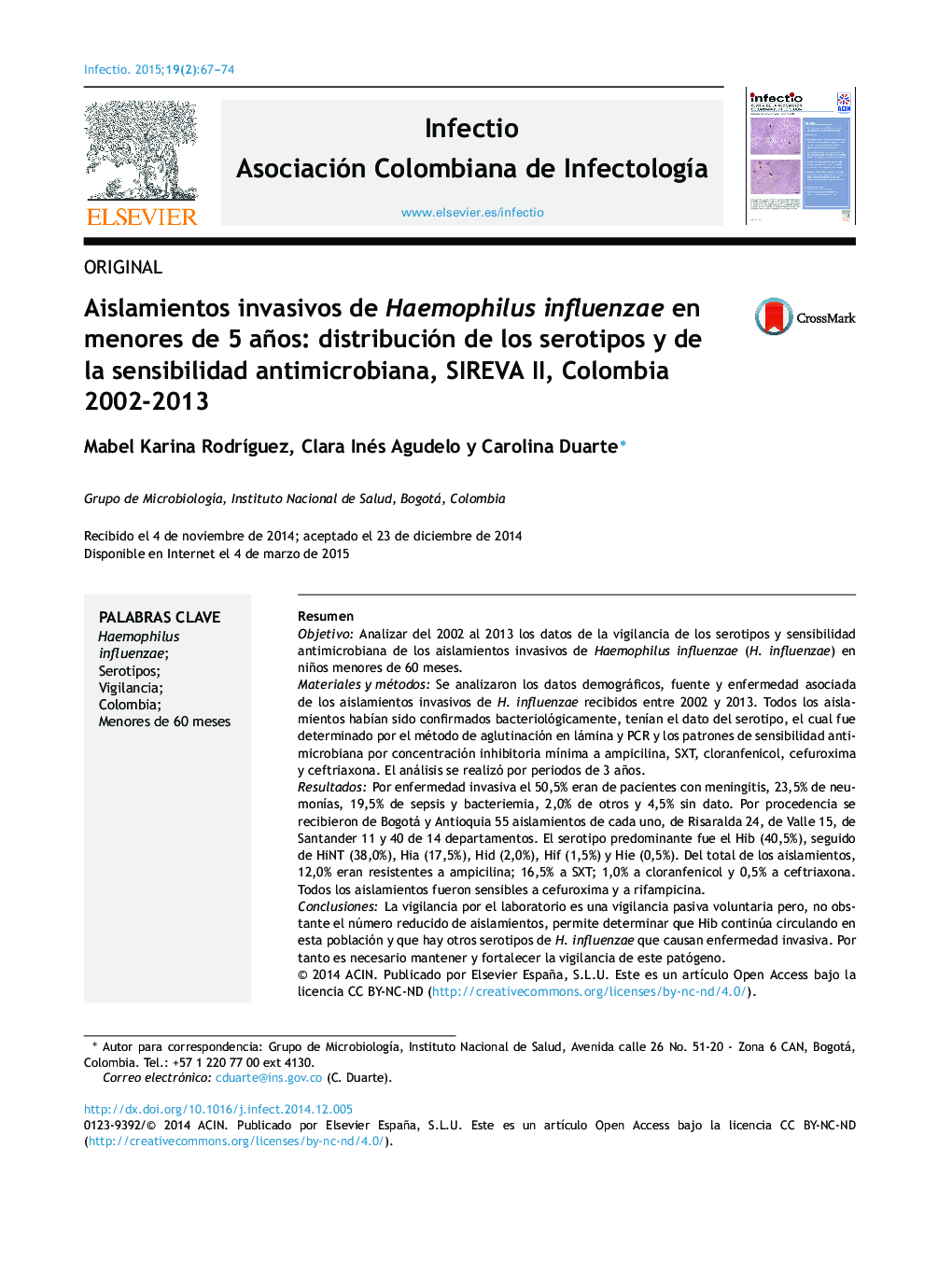| کد مقاله | کد نشریه | سال انتشار | مقاله انگلیسی | نسخه تمام متن |
|---|---|---|---|---|
| 3403665 | 1223081 | 2015 | 8 صفحه PDF | دانلود رایگان |

ResumenObjetivoAnalizar del 2002 al 2013 los datos de la vigilancia de los serotipos y sensibilidad antimicrobiana de los aislamientos invasivos de Haemophilus influenzae (H. influenzae) en niños menores de 60 meses.Materiales y métodosSe analizaron los datos demográficos, fuente y enfermedad asociada de los aislamientos invasivos de H. influenzae recibidos entre 2002 y 2013. Todos los aislamientos habían sido confirmados bacteriológicamente, tenían el dato del serotipo, el cual fue determinado por el método de aglutinación en lámina y PCR y los patrones de sensibilidad antimicrobiana por concentración inhibitoria mínima a ampicilina, SXT, cloranfenicol, cefuroxima y ceftriaxona. El análisis se realizó por periodos de 3 años.ResultadosPor enfermedad invasiva el 50,5% eran de pacientes con meningitis, 23,5% de neumonías, 19,5% de sepsis y bacteriemia, 2,0% de otros y 4,5% sin dato. Por procedencia se recibieron de Bogotá y Antioquia 55 aislamientos de cada uno, de Risaralda 24, de Valle 15, de Santander 11 y 40 de 14 departamentos. El serotipo predominante fue el Hib (40,5%), seguido de HiNT (38,0%), Hia (17,5%), Hid (2,0%), Hif (1,5%) y Hie (0,5%). Del total de los aislamientos, 12,0% eran resistentes a ampicilina; 16,5% a SXT; 1,0% a cloranfenicol y 0,5% a ceftriaxona. Todos los aislamientos fueron sensibles a cefuroxima y a rifampicina.ConclusionesLa vigilancia por el laboratorio es una vigilancia pasiva voluntaria pero, no obstante el número reducido de aislamientos, permite determinar que Hib continúa circulando en esta población y que hay otros serotipos de H. influenzae que causan enfermedad invasiva. Por tanto es necesario mantener y fortalecer la vigilancia de este patógeno.
ObjectiveTo analyze 2002-2013 surveillance data on the serotypes and antimicrobial sensitivity of invasive Haemophilus influenzae (H. influenzae) isolates in children younger than 60 months.Materials and methodsWe analyzed the demographic data, source and associated diseases of invasive HI isolates from cases recorded from 2002-2013. All isolates had been bacteriologically confirmed and had data on their serotype, which was determined by the slide agglutination method and polymerase chain reaction. The antimicrobial sensitivity patterns were determined by minimum inhibitory concentration of ampicillin, trimethoprim-sulfamethoxazole, chloramphenicol, cefuroxime and ceftriaxone. The analysis was conducted in 3-year periods.ResultsAccording to invasive disease, 50.5% of patients had meningitis, 23.5% had pneumonia, 19.5% had sepsis and bacteremia, 2.0% had other diseases and 4.5% lacked data. By origin, 55 isolates each were received from Bogota and Antioquia, 24 were from Risaralda, 15 were from Valle, 11 were from Santander and 40 came from 14 departments. The predominant serotype was Hib (40.5%), followed by HiNT (38.0%), Hia (17.5%), Hid (2.0%), Hif (1.5%) and Hie (0.5%). Of the total isolates, 12.0% were resistant to ampicillin; 16.5% to trimethoprim-sulfamethoxazole, 1.0% to chloramphenicol and 0.5% to ceftriaxone. All isolates were sensitive to cefuroxime and rifampicin.ConclusionsLaboratory surveillance is a voluntary passive surveillance; however, the low number of isolates helped determine that Hib continues to circulate in this population and that there are other H. influenzae serotypes that cause invasive disease. Therefore, surveillance of this pathogen needs to be maintained and reinforced.
Journal: Infectio - Volume 19, Issue 2, April–June 2015, Pages 67–74